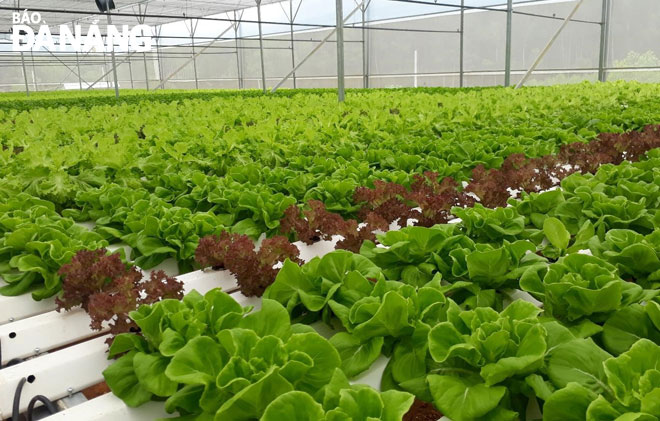Positive results from technological applications in agriculture
The applications of advanced technologies and new breeds in agricultural production in suburban Hoa Vang District, Da Nang started in 2015, in active response to the district authorities-approved project to promote the hi-tech application in agriculture with the aim of enhancing the productivity and the quality of agricultural products for urban use by 2020.
 |
| A view of a hi-tech vegetable growing area in Hoa Ninh Commune, Hoa Vang District |
Mr Nguyen Huu Thinh, the developer of the 3ha Tan An organic vegetable growing area in Hoa Khuong Commune, said, vegetables are grown in nets houses equipped with drip irrigation system. It is able to save water and nutrients by allowing water to drip slowly to the roots of plants, either from above the soil surface or buried below the surface. Thanks to its technological applications in production in a flexible and innovative manner, Mr Thinh’s establishment earns over 1 billion VND in annual profit.
According to the Hoa Vang Office of Agriculture and Rural Development, in terms of fruit and vegetable production, since 2017, investment from the district-budget has been poured into the building of greenhouses protecting crops from adverse weather condition in Hoa Ninh Commune’s Trung Nghia Village and Hoa Phu Commune’s Dong Lam Village, along with hydroponic farming models in Hoa Ninh Commune.
These dedicated organic vegetable growing areas, meeting the Viet Nam Good Agricultural Practices (VietGap) standards, have been established in a bid to satisfy the growing demand for healthy and fresh food products.
To date, advanced technological cultivation methods have been applied successfully on a total of more than 10.5 ha of specialised vegetable production land. Such agricultural products as red-skinned dragon fruit with red flesh, guava, green-skinned pomelos, and straw mushroom, have also affirmed their position in the city’s market.
As for rice production activities, since 2013, the district has seen many positive results from organic production models. Especially, from 2018, 2 new high-yield rice varieties have been developed successfully in Hoa Chau Commune which have been much preferred by local consumers.
In regard to animal husbandry and aquaculture industries, a backyard chicken raising model ensuring biological safety has been approved highly effective in a bid to ensure sufficient supplies of healthy and delicious chicken meat for local residents.
These chickens are allowed to range freely instead of being kept in coops as other varieties do to satisfy their need for ample living space, and they are fed rice, cornmeal and other types of poultry feed. Free-range chickens are less prone to disease than industrially-raised ones. Besides, free-range chickens are raised naturally so that their eggs have a bigger yolk and better flavour than eggs from industrially-raised chickens. In comparison with traditionally-raised chicken which are roaming all day to search out much of their foods, ones raised through the application of biological safety techniques bring more economic benefits to raisers.
Besides chickens, biological safety techniques are now being applied in raising such types of livestock as cows and pigs in a bid to ensure the sustainable development of husbandry industry.
Freshwater aquaculture production models ensuring biological safety, with a focus on producing new high-value varieties have been applied effectively in farming in Khuong My Village, Hoa Phong Commune.
To date, some hi-tech, organic agricultural production models in this suburban district have brought about quite fruitful results, fully tapping the location’s natural advantages and its development potential.
In the coming time, importance will be attached to continue the usage of advanced cultivation techniques to produce a variety of robust, disease-free, high-yielding products, hereby enabling farmers to earn more incomes and fostering the district’s growth.